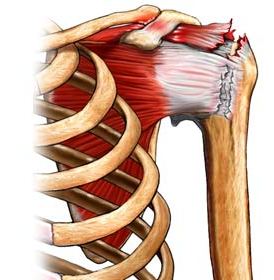Treatment of rotator cuff
Description treating rotator cuff
Rotator cuff – a group of four muscles in the arms of the shoulder and upper arm. The muscles help to move the arm at the shoulder joint, as well as help to maintain joint is in a stable position. Shoulder muscles associated with tendons – powerful, flexible cord. Tendons can be damaged as a result of illness or injury.
Treatment of Rotator cuff is an operation to restore the gap or rotator cuff injury.

The reasons for the treatment of rotator cuff
Your doctor may recommend this procedure for the treatment of these disorders:
- Cuff injury, that does not go with rest and physical therapy;
- Complete tendon rupture;
- Chronic pain and weakness from a partial tendon rupture.
Possible complications of the treatment of rotator cuff
Complications are rare, but the procedure does not guarantee the absence of risk. If you plan to restore damaged cuff, you need to know about possible complications, which may include:
- Infection;
- Bleeding;
- Scars in the shoulder joint;
- The operation does not lead to the desired improvement;
- Reaction to anesthesia.
Factors, that may increase the risk of complications:
- Smoking.
How is the treatment of rotator cuff?
Preparation for the procedure
Your doctor may order the following:
- Medical checkup;
- Blood tests;
- Shoulder X-ray;
- MRI of the shoulder – test, which uses magnetic waves, to make pictures of structures inside the body.
In the run-up procedure:
- Tell your doctor about taking any medications. A week before surgery, perhaps, you need to stop taking certain drugs:
- Aspirin or other anti-inflammatory drugs;
- Blood thinners, such as clopidogrel (Plaviks) or warfarin;
- Do not eat or drink for at least 8 hours before surgery;
- We need to organize a trip for the operation and back home from the hospital.
Anesthesia
The operation is performed under the general anesthesia, which blocks the pain and the patient support in a sleep state during operation.
Description of the procedure for treating rotator cuff
There are two methods, used to restore the rotator cuff:
Open surgery
The doctor will make a large incision in the skin of the shoulder. The torn tendon will be sewn back and rosstanovleny. Then the incision is closed sutures or staples.
Artroskopicheskaya surgery
The shoulder is performed several small incisions, through one of which is inserted a tool called an arthroscope. At its end is a tiny camera, that allows the doctor to see the internal structure of the treated area. For other sections will be inserted surgical instruments, used to restore the tendon.
After performing the operation area is bandaged. Hand placed in a special bandage, which would prevent its movement during healing.
How long will the treatment of rotator cuff?
From 1,5 to 2 hours.
Treatment of rotator cuff – Will it hurt?
Anesthesia prevents pain during the procedure. After surgery, you may feel some discomfort. Pain or soreness after the surgery removed with the help of painkillers.
The average time of stay in the hospital after treatment of injuries of the rotator cuff
You will be able to go home the day of surgery. Sometimes, perhaps, will have to stay in hospital for a day.
Care after treatment of injuries of the rotator cuff
After returning home, follow these steps:, to ensure the normal recovery:
- Prikladyvajte ice, to reduce swelling in the first 24-48 hours after surgery;
- Take medicines prescribed by the doctor;
- Keep the bandage clean and dry;
- Ask the doctor, when it is safe to shower, bathe, or to expose the surgical site to water;
- Try not to move the operated hand to doctor's permission;
- To work, usually, You can go back a few days after the operation;
- Do the exercises, appointed physiotherapist. Therapy helps restore strength and range of motion of the shoulder;
- Be sure to follow your doctor's instructions.
Rotator cuff heals months. Full restoration of the strength and range of motion can take over a year. Regular exercise is the key to a faster recovery.
Contact your doctor after treatment of injuries of the rotator cuff
After returning home, you need to see a doctor, If the following symptoms:
- Signs of infection, including fever and chills;
- Redness, edema, strong pain, bleeding, or discharge from the incision;
- Cough, breathlessness, chest pain, or severe nausea or vomiting;
- Gapping.
